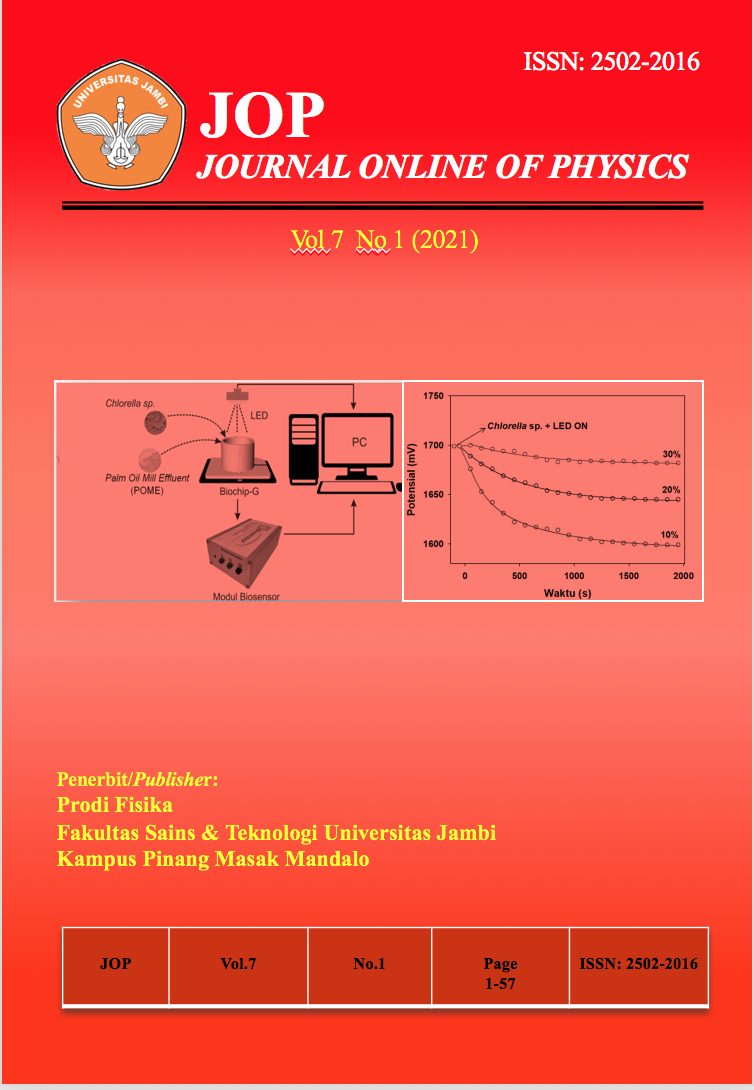PENGARUH JARAK, KEMIRINGAN, DAN INTENSITAS CAHAYA PADA ANALISIS UKURAN PORI MASKER KAIN MENGGUNAKAN SMARTPHONE
DOI:
https://doi.org/10.22437/jop.v7i1.14502Keywords:
covid-19, cloth mask, ImageJ, microscope, smartphoneAbstract
One of the common strategies used to minimize the spread of Covid-19 is to wear a cloth mask. Cloth masks have a lower effectiveness value compared to other types of masks but have the potential to be used as an alternative, especially during a pandemic. Smartphone can be used as an initial idea for determining the quality of a cloth mask. In taking pore images, there are factors that have the potential to affect the results of pore size, namely distance, angle of inclination, and light intensity. Taking photos of masks with a magnification application is done with three variations, namely distance, angle, and light intensity. The distance for taking pore images is varied to 3, namely 8 cm; 10 cm; and 12 cm. The image capture angle is varied to 0p; 5o; and 10o. measurement using a distance of 10 cm has the closest value from the measurement results by taking images using a microscope, which is 0.232 mm. In the variation of the angle, the angle that is parallel or 0o to the plane of the cloth mask has a value that is close to the microscope measurement, which is 0.232 mm. The light intensity measured using a lux meter which shows the results of 240 has a value that is closest to taking an image using a microscope, which is 0.221 mm.
Downloads
References
Budiana, B., Nakul, F., Wivaius, N., Sugandi, B., Yolanda, R., Aminullah, D., et al. 2020. Analisis Kekasaran Permukaan Besi ASTM36 dengan Menggunakan Surfest dan ImageJ. Journal of Applied Electrical Engineering , 4 (2): 49-54.
Chungthai, A., Seale, H., & Macintyre, C. 2020. Effectiveness of Cloth Masks for Protection Against Severe Acute Respiratory Syndrom Coronavirus 2. Emerging Infectious Diseases , 26 (10): 1-5.
Esposito, S., Principi, N., Leung, C., & Migliori, G. 2020. Universal Use of Face Masks for Success Againts COVID-19: Evidence and Implications for Preventing Policies. European Rspiratory Journal , 55 (6): 1-5.
Igathinathane, C., Pordesimo, L., Columbus, E., Batchelor, W., & Methuku, S. 2008. Shape Identification and Particles Size Distributon from Basic Shape Parameters Using ImageJ. Computers and Electronics in Agriculture , 63: 168-182.
Neupane, B., Chaudhary, R., & Sharma, A. 2020. A Smartphone Microscopic Method for Rapid Screening of Cloth Facemask Fabrics During Pandemics. PeerJ , 8: 1-11.
Nichele, L., Persichetti, V., Lucidi, M., & Cincotti, G. 2020. Quantitative Evaluation of ImageJ Thresholding Algorithms for microbial Cell Counting. OSA Continuum , 3 (6): 1417-1427.
Ruaden, C., Schindelin, J., Hiner, M., DeZonia, B., Walter, A., Arena, E., et al. 2017. ImageJ2: ImageJ for the Next Generation of Scientific Image Data. BMC Bioinformatics , 18 (1): 1-26.
Santos, M., Torres, D., Cardoso, P., Pandis, N., Mir, C., Medeiross, R., et al. 2020. Are Cloth Masks a Substitute to Medical Masks in Reducing Transmission and Contamination? A systematic Review. Brazilian Oral Research , 34: 1-17.
Sunaryo, D. 2020. Pembuatan Masker Kain Sebagai Pencegahan Penularan Virus serta Mengoptimalkan Pendapatan di Masa Pandemi Covid-19 bagi Masyarakat di Desa Sukaratu. Jurnal Abdidas , 1 (4): 183-192.
Sunjaya, A., & Morawska, L. 2020. Evidence Review and Practice Recommendation on the Material, Design, and Maintenance of Cloth Masks. Disaster Medicine and Public Health Preparedness , 14 (5): 42-46.
Tcharkhtchi, A., Abbasnezhad, N., Seydani, M., Zirak, N., Farzaneh, & Shirinbayan, M. (2021). An Overview of Filtration Efficiency Through the Masks: Mechanism of the Aerosols Penetration. Bioactive Material , 6: 106-122.











